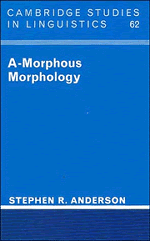
-
Select format
-
- Publisher:
- Cambridge University Press
- Publication date:
- January 2011
- June 1992
- ISBN:
- 9780511586262
- 9780521378666
- Dimensions:
- Weight & Pages:
- Dimensions:
- (228 x 152 mm)
- Weight & Pages:
- 0.629kg, 452 Pages
You may already have access via personal or institutional login- Series:
- Cambridge Studies in Linguistics (62)
Book description
In A-Morphous Morphology, Stephen Anderson presents a theory of word structure which relates to a full generative grammar of language. He holds word structure to be the result of interacting principles from a number of grammatical areas, and thus not localized in a single morphological component. Dispensing with classical morphemes, the theory instead treats morphology as a matter of rule-governed relations, minimizing the non-phonological internal structure assigned to words and eliminating morphologically motivated boundary elements. Professor Anderson makes the further claim that the properties of individual lexical items are not visible to, or manipulated by, the rules of the syntax, and assimilates to morphology special clitic phenomena. A-Morphous Morphology maintains significant distinctions between inflection, derivation, and compounding, in terms of their place ina grammar. It also contains discussion of the implications of this new A-Morphous position analysis of word structure.
Contents
Metrics
Altmetric attention score
Full text views
Full text views help Loading metrics...
Loading metrics...
* Views captured on Cambridge Core between #date#. This data will be updated every 24 hours.
Usage data cannot currently be displayed.
Accessibility standard: Unknown
Why this information is here
This section outlines the accessibility features of this content - including support for screen readers, full keyboard navigation and high-contrast display options. This may not be relevant for you.
Accessibility Information
Accessibility compliance for the PDF of this book is currently unknown and may be updated in the future.


